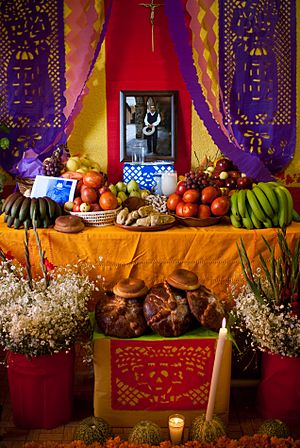Ofrenda facts for kids
An ofrenda (which means "offering" in Spanish) is a special collection of objects placed on a display during the yearly and traditional Mexican celebration called Día de Muertos. An ofrenda is usually made for a person who has died. It is meant to welcome them back for a visit. These displays are filled with the deceased person's favorite things, pictures, and food.
Contents
Ofrendas for Day of the Dead
Ofrendas are a very important part of the Día de Muertos (Day of the Dead) celebration. This holiday is celebrated mainly in Mexico, but also in other parts of Latin America and by people of Mexican heritage around the world. It is a time to remember and honor loved ones who have passed away. People believe that on this special day, the spirits of the dead return to visit their families.
What is Día de Muertos?
Día de Muertos is not a sad holiday. Instead, it is a joyful and colorful celebration of life and death. It usually takes place on November 1st and 2nd. Families gather to celebrate the lives of their ancestors and friends who are no longer with them. They share stories, music, and special foods. The ofrenda is the heart of this celebration, acting as a welcoming place for the spirits.
Why Do People Make Ofrendas?
People create ofrendas to invite the spirits of their loved ones to come back and visit. It is a way to show respect and love for those who have died. The ofrenda helps guide the spirits home and provides them with things they might enjoy after their long journey. It is a way for families to feel connected to their ancestors and keep their memory alive.
What Goes on an Ofrenda?
An ofrenda is usually built in layers, like a staircase, representing the journey between the living and the dead. Each item placed on the ofrenda has a special meaning. The items are chosen carefully to honor the person being remembered.
Pictures and Personal Items
A photograph of the deceased person is often placed at the top of the ofrenda. This helps the spirit know that the ofrenda is for them. Other personal items, like favorite clothes, tools, or toys, are also included. These items remind everyone of the person's life and personality.
Food and Drink
Food and drinks are a very important part of an ofrenda. People prepare the favorite foods and drinks of the person who has passed away.
- Pan de Muerto: This is a special sweet bread shaped like bones or a skull. It is a traditional offering.
- Sugar Skulls (Calaveras): These colorful skulls are made of sugar and decorated with bright icing. They represent the sweetness of life and the acceptance of death.
- Fresh Fruit and Vegetables: Seasonal fruits like oranges, bananas, and jícama are often included.
- Drinks: Water is always present to quench the spirit's thirst after their journey. Other drinks might include soda, coffee, hot chocolate, or even alcoholic beverages if they were the deceased's favorite.
Candles and Light
Candles are placed on the ofrenda to light the way for the spirits. They help guide the spirits from the afterlife back to their homes. Each candle might represent a specific family member who has passed away. The flickering flame also symbolizes life and hope.
Flowers
Cempasúchil (marigold flowers) are the most common flowers used on ofrendas. Their bright orange and yellow colors and strong scent are believed to attract the spirits and guide them to the ofrenda. Petals are sometimes scattered on the floor, forming a path from the entrance of the home to the ofrenda.
Incense and Copal
Copal is a type of resin that is burned as incense. Its smoke is believed to purify the area and carry prayers and messages to the spirits. The scent also helps guide the spirits to the ofrenda.
Salt and Water
Salt is often placed on the ofrenda to purify the spirits and prevent them from being corrupted. Water is offered to quench the thirst of the spirits after their long journey.
Where Are Ofrendas Placed?
Ofrendas can be found in many places during Día de Muertos.
- Homes: Most families build an ofrenda in their home, often in a living room or dining area.
- Cemeteries: Some families also build smaller ofrendas or decorate gravesites at cemeteries. They might spend the night at the cemetery, sharing food and stories.
- Public Spaces: In many towns and cities, large public ofrendas are created in parks, schools, and museums. These often honor famous people or important figures.

See also
 In Spanish: Altar de muertos para niños
In Spanish: Altar de muertos para niños

